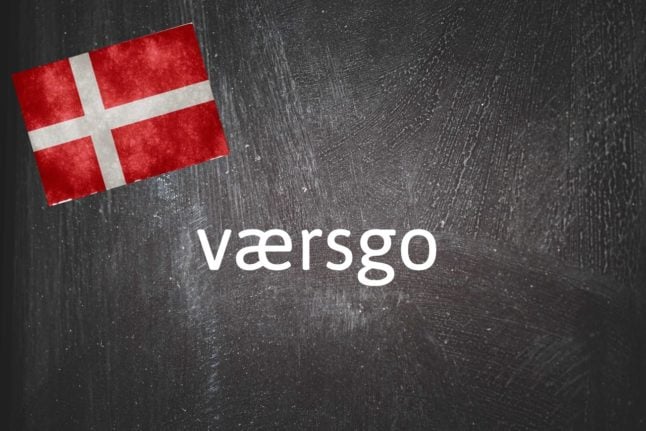What is værsgo?
Originally three separate words: vær så god, which have been contracted to the shorter værsgo, although you may sometimes also see værsgo written as værsagod or even værs’god or værsgo’.
Vær is the imperative form of at være (“to be”), which you’ll probably know if you’ve taken Danish classes of any level.
Unlike the English “to be”, at være is easy to conjugate because it doesn’t change between the first, second and third person. In other words, “I am — you are — she/he is” becomes jeg er — du er — hun/han er. Who said Danish was a difficult language?
Back to the imperative form of “to be”, though. Most Danish imperatives simply remove the e from the end of the infinitive form: at løbe (“to run”) becomes løb! (run!). This is also the case with at være.
As such, værsgo or vær så god is literally “be so good” or more loosely, “be so kind”. French speakers might notice a similarity to the French term for “please”, s’il vous plait (literally: “if it pleases you”).
There are some parallels here with another Danish term of politeness, venligst.
Why do I need to know værsgo?
Værsgo is usually translated as “you’re welcome” but can also mean something like “please” or “here you go”.
There are three main contexts in which you might hear or use this word.
Firstly, if someone says tak (“thank you”) to you, perhaps for holding a door open for you or after you do them a favour, you can respond værsgo (“you’re welcome”). Alternative options in this situation might be det var så lidt (“it was nothing”) or the more quaint ingen årsag (“no trouble”).
Værsgo can also be used passive-aggressively if you don’t receive a tak when you might expect it, so for example if you hold the door open and someone passes through it without a nod or word of thanks, you could mutter værsgo under your breath. Our advice would be not to overdo this, though: sometimes people don’t see the need to say thanks for small courtesies and this is more of a social norm than a deliberate lack of politeness.
The second context for using værsgo is when giving something to someone, such as when a waiter hands you your drink or cake, or when your boss hands out agendas at the start of a meeting. Here, it means something like “here you go”, similar to prego in Italian.
And finally, it can be used as a slightly formal way of saying “please”. Danish doesn’t have a direct translation for please. But if you want to stress politeness and formality, you can start a sentence with something like værsgo og, which approximately means something like “please be so kind as to…” For example: værsgo at sidde is “please sit down” or “please take a seat”.



 Please whitelist us to continue reading.
Please whitelist us to continue reading.
Member comments